PSFC (MIT) and CFS are developing ‘SPARC’: a high-temperature superconductor capable of 140MW fusion power in 10 seconds!
SPARC is a tokamak (magnetic coil in a torus shape) being developed by Commonwealth Fusion Systems (CFS) in partnership with the Massachusetts Institute of Technology’s (MIT) Plasma Science And Fusion Center (PSFC). Despite its small size, SPARC is going to do this with a margin over breakeven, and may be capable of producing up to 140 MW of fusion power during 10-second bursts. It also intends to validate the technology and physics needed to construct a power plant based on the ‘affordable, robust, compact’ (ARC) fusion power plant idea.
What’s SPARC?
Before talking about SPARC and its special traits, we need to explain the function of a superconductor. In short, fuel is heated to temperatures exceeding 100 million degrees to initiate the fusion process. During that phase, the matter is in a condition known as plasma, in which the particles have a net electric charge. This plasma must be adequately shielded from regular matter in order to stay hot. Magnetic fields produced by superconductors are used to provide the necessary thermal insulation. The stronger the magnetic field, the greater the confining force on the charged particles in the plasma, and therefore the better the insulation, allowing for a much smaller and more efficient fusion device.
SPARC is a high-temperature superconducting (HTS) magnet made of yttrium barium copper oxide (YBCO), and is the complete opposite of Low-temperature superconductors (LTS), which are conventionally used today. This makes them carry a much higher amount of current, while keeping the form factor much smaller when compared to LTS.
What’s so special about it?
The most innovative aspect of SPARC, is not its design, but its Fusion Energy Gain Factor (Q). This factor, in short, expresses the required fusion power during a nuclear fusion versus the power that you need to put into the system, to maintain the plasma in a steady state.
To make it easier to understand, a Q=10 would mean that for a 500MW production of fusion power, you’d need 50MW of input thermal energy. The record holder of the highest Q, was JET in 1997 with Q=0.67 and JT-60 with Q=1.25. Currently, SPARC has already surpassed it by reaching a Q>2, and aims for a max. Q≈11, which sounds out of this world already.
What benefits will this technology bring to us?
MIT believes that this technology will be scaled for usage in both fusion and non-fusion applications. Besides that, this breakthrough will:
- Commercialize fusion;
- Open the door to other applications related to research and industry;
- Help MIT realize the most significant fusion experiments ever performed;
- Provide a solution to the net power production from confined plasma, a problem that’s been “bugging” scientists for more than 60 years;
- Enable breakthroughs and crucial studies related to self-heated plasma;
- Enable the flourishing of fusion technology.
The project isn’t over yet. There’s much to be done, but MIT seems confident enough in reaching its set target.
Technical Specifications
| Major radius | 1.85 m |
|---|---|
| Minor radius | 0.57 m |
| Plasma volume | 20 m3 |
| Magnetic field | 12.2 T |
| Heating power | 25 MW |
| Fusion power | (140 MW) |
| Discharge duration | (10 s) |
| Plasma current | (8.7 MA) |
| Plasma temperature | (80×106 K) |
Useful Links
Do you think SPARC will solve the energy crisis?
Please, let us know in the comments, and subscribe & follow us for more.





Comments
Loading…